Racing, gaming, and entertainment company Churchill Downs (NASDAQ:CHDN) announced better-than-expected results in Q1 CY2024, with revenue up 5.6% year on year to $590.9 million. It made a non-GAAP profit of $1.13 per share, improving from its profit of $0.98 per share in the same quarter last year.
Churchill Downs (CHDN) Q1 CY2024 Highlights:
- Revenue: $590.9 million vs analyst estimates of $565.9 million (4.4% beat)
- EPS (non-GAAP): $1.13 vs analyst estimates of $0.83 (36.8% beat)
- Gross Margin (GAAP): 31.3%, up from 30.7% in the same quarter last year
- Free Cash Flow of $99.7 million is up from -$71.9 million in the previous quarter
- Market Capitalization: $9.09 billion
Famous for hosting the Kentucky Derby, Churchill Downs (NASDAQ:CHDN) operates a horse racing, online wagering, and gaming entertainment business in the United States.
Churchill Downs was founded in 1875 with the opening of its namesake racetrack in Louisville, Kentucky, primarily to showcase the Kentucky Derby. The Derby was created to bring high-quality horse racing to the United States. The company's founding was driven by a passion for horse racing and a vision to create a premier racing event that would rival the best in the world.
Today, Churchill Downs offers a diverse range of services that extend beyond its famed horse racing events. These include online betting platforms, casino gaming, and other entertainment services. By providing a digital wagering platform, the company addresses the modern consumer's desire for accessible and convenient betting options. Additionally, its casinos offer a variety of gaming and entertainment options, catering to a broad audience.
Churchill Downs generates revenue through a mix of sources, including racetrack operations, online wagering services, and casino gaming. The company's business model is based on leveraging the iconic status of its horse racing events while diversifying into digital gaming and casinos. This strategy capitalizes on the traditional appeal of horse racing and also adapts to changing consumer preferences in the entertainment and gaming industries.
Gaming Solutions
Gaming solution companies operate in a dynamic and evolving market, and the digital transformation of the gaming industry presents significant opportunities for innovation and growth, whether it be immersive slot machine terminals or mobile sports betting. However, the gaming solution industry is not without its challenges. Regulatory compliance is a crucial consideration as companies must navigate a complex and often fragmented regulatory landscape across different jurisdictions. Changes in regulations can impact product offerings, operational practices, and market access, requiring companies to maintain flexibility and adaptability in their business strategies. Additionally, the competitive nature of the industry necessitates continuous investment in research and development to stay ahead of competitors and meet evolving consumer demands.
Competitors in the gaming and horse racing industry include MGM Resorts (NYSE:MGM), Caesars Entertainment (NASDAQ:CZR), and PENN Entertainment (NASDAQ:PENN).Sales Growth
Examining a company's long-term performance can provide clues about its business quality. Any business can put up a good quarter or two, but the best consistently grow over the long haul. Churchill Downs's annualized revenue growth rate of 18.1% over the last five years was solid for a consumer discretionary business.
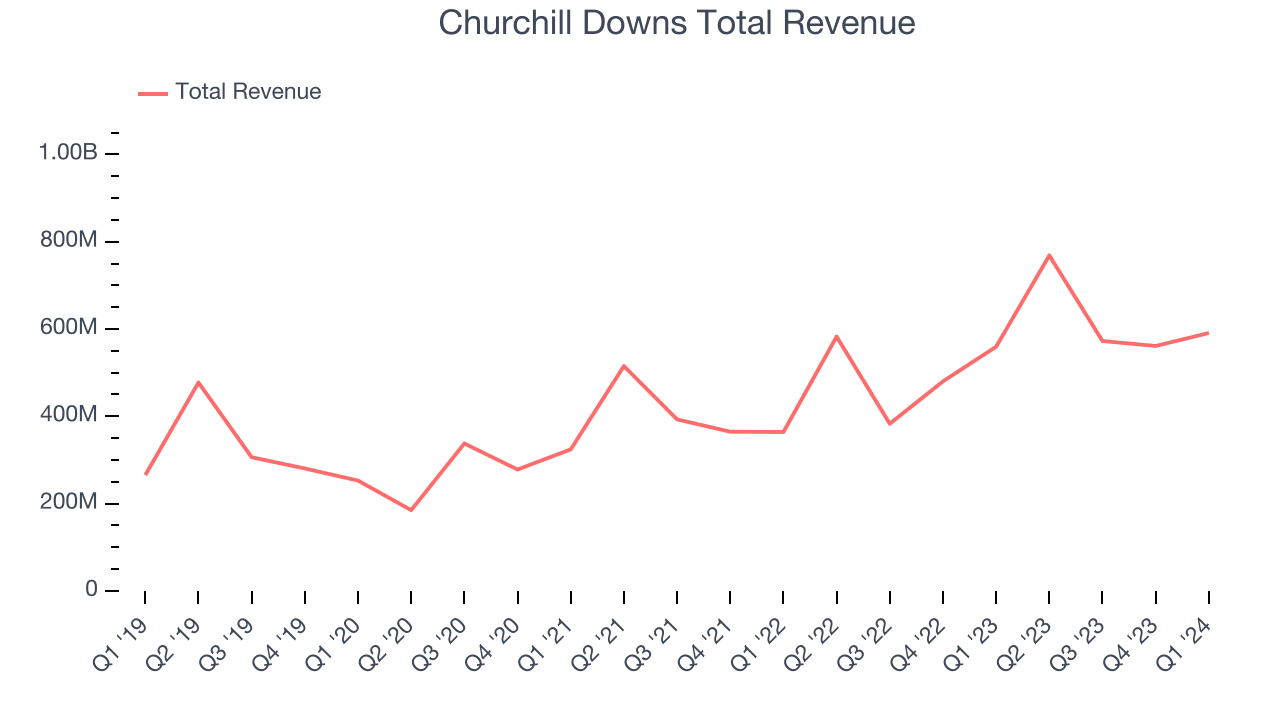
Within consumer discretionary, a long-term historical view may miss a company riding a successful new product or emerging trend. That's why we also follow short-term performance. Churchill Downs's healthy annualized revenue growth of 23.4% over the last two years is above its five-year trend, suggesting its brand resonates with consumers.
This quarter, Churchill Downs reported solid year-on-year revenue growth of 5.6%, and its $590.9 million of revenue outperformed Wall Street's estimates by 4.4%. Looking ahead, Wall Street expects sales to grow 12% over the next 12 months, an acceleration from this quarter.
Operating Margin
Operating margin is a key measure of profitability. Think of it as net income–the bottom line–excluding the impact of taxes and interest on debt, which are less connected to business fundamentals.
Churchill Downs has been a well-managed company over the last eight quarters. It's demonstrated it can be one of the more profitable businesses in the consumer discretionary sector, boasting an average operating margin of 21.4%.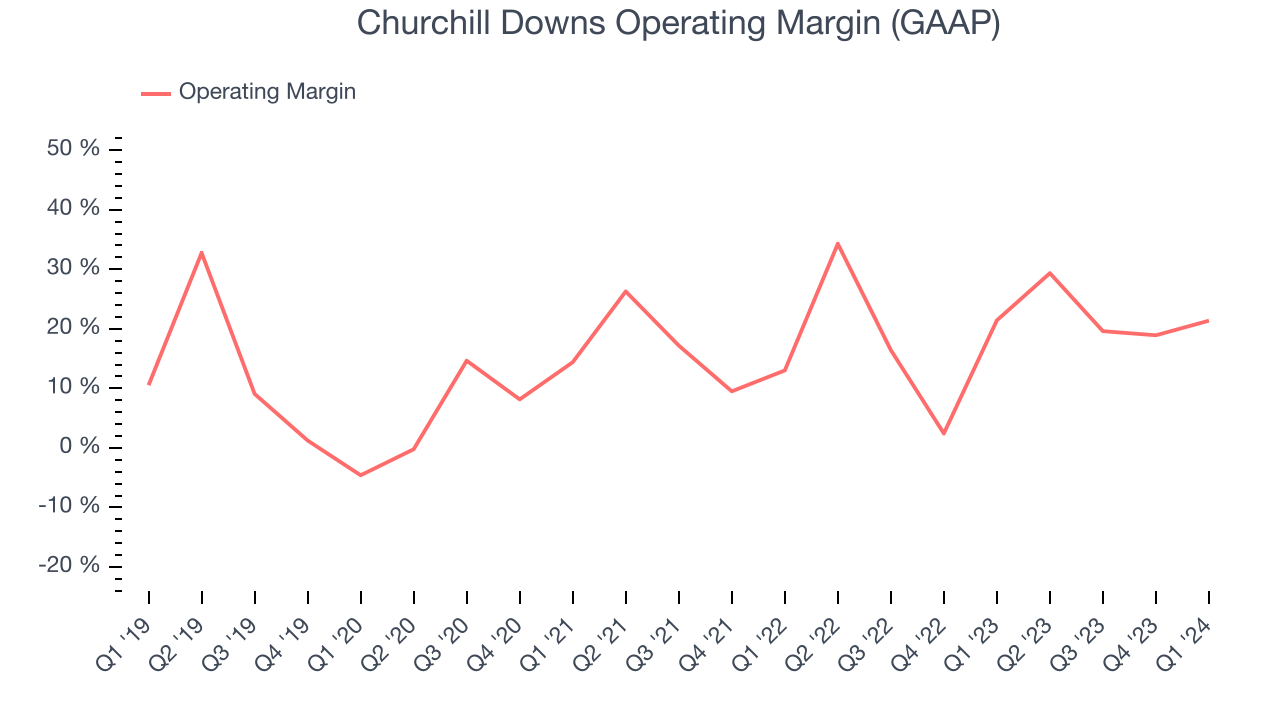
In Q1, Churchill Downs generated an operating profit margin of 21.4%, in line with the same quarter last year. This indicates the company's costs have been relatively stable.
Over the next 12 months, Wall Street expects Churchill Downs to become more profitable. Analysts are expecting the company’s LTM operating margin of 22.9% to rise to 27.3%.EPS
We track long-term historical earnings per share (EPS) growth for the same reason as long-term revenue growth. Compared to revenue, however, EPS highlights whether a company's growth was profitable. 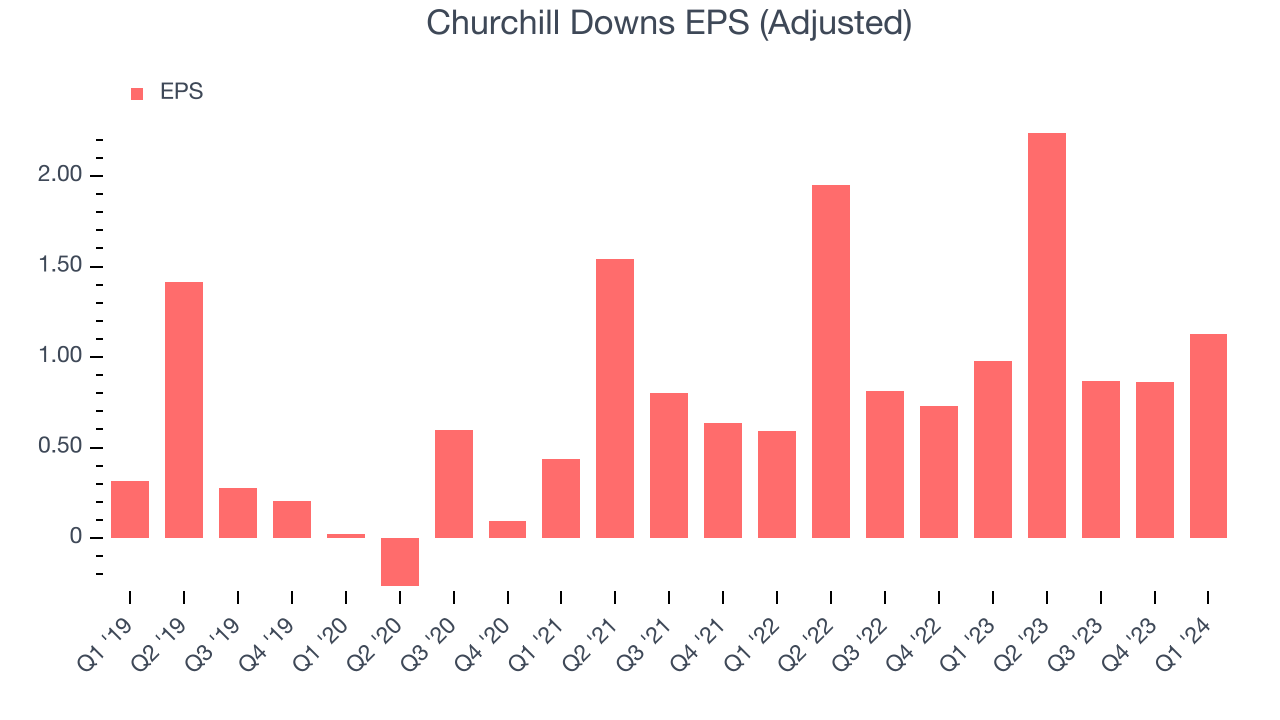
Over the last five years, Churchill Downs's EPS grew 160%, translating into a remarkable 21.1% compounded annual growth rate. This performance is higher than its 18.1% annualized revenue growth over the same period. There are a few reasons for this, and understanding why can shed light on its fundamentals.
While we mentioned earlier that Churchill Downs's operating margin was flat this quarter, a five-year view shows its margin has expanded 10.8 percentage points while its share count has shrunk 8%. Improving profitability and share buybacks are positive signs as they juice EPS growth relative to revenue growth.In Q1, Churchill Downs reported EPS at $1.13, up from $0.98 in the same quarter last year. This print beat analysts' estimates by 36.8%. Over the next 12 months, Wall Street expects Churchill Downs to grow its earnings. Analysts are projecting its LTM EPS of $5.10 to climb by 23.4% to $6.29.
Cash Is King
Although earnings are undoubtedly valuable for assessing company performance, we believe cash is king because you can't use accounting profits to pay the bills.
Over the last two years, Churchill Downs broke even from a free cash flow perspective, subpar for a consumer discretionary business.
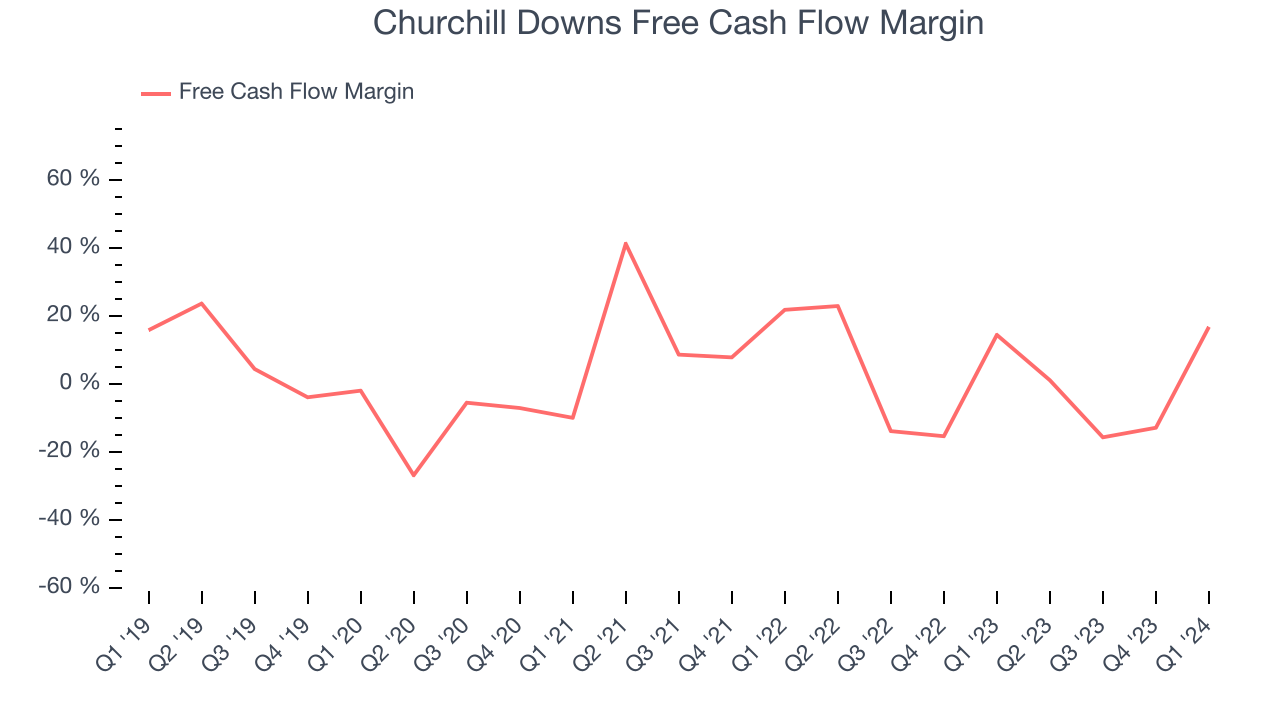
Churchill Downs's free cash flow came in at $99.7 million in Q1, equivalent to a 16.9% margin and up 22.8% year on year.
Return on Invested Capital (ROIC)
EPS and free cash flow tell us whether a company was profitable while growing revenue. But was it capital-efficient? Enter ROIC, a metric showing how much operating profit a company generates relative to how much money the business raised (debt and equity).
Churchill Downs's five-year average return on invested capital was 7.5%, somewhat low compared to the best consumer discretionary companies that pump out 25%+. Its returns suggest it historically did a subpar job investing in profitable business initiatives.
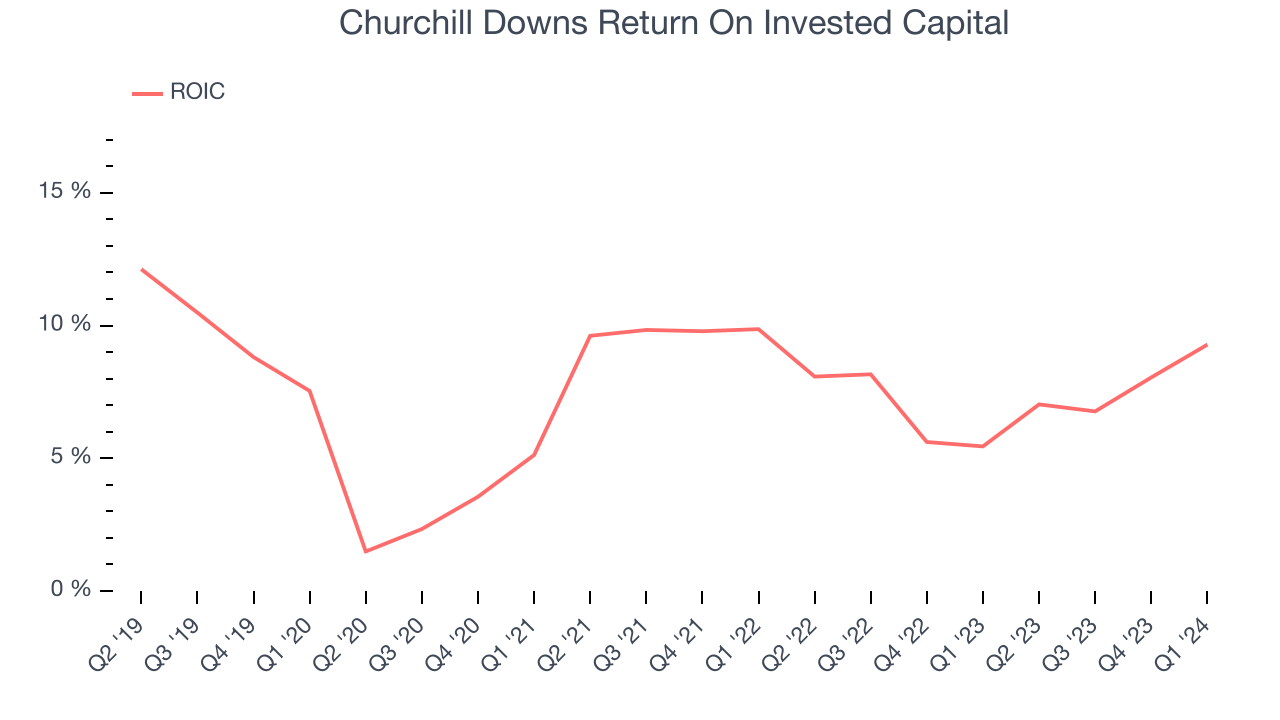
The trend in its ROIC, however, is often what surprises the market and drives the stock price. Over the last few years, Churchill Downs's ROIC averaged 1 percentage point increases. This is a good sign, and if the company's returns keep rising, there's a chance it could evolve into an investable business.
Balance Sheet Risk
As long-term investors, the risk we care most about is the permanent loss of capital. This can happen when a company goes bankrupt or raises money from a disadvantaged position and is separate from short-term stock price volatility, which we are much less bothered by.
Churchill Downs reported $149.4 million of cash and $4.93 billion of debt on its balance sheet in the most recent quarter. As investors in high-quality companies, we primarily focus on two things: 1) that a company's debt level isn't too high and 2) that its interest payments are not excessively burdening the business.
With $1.04 billion of EBITDA over the last 12 months, we view Churchill Downs's 4.6x net-debt-to-EBITDA ratio as safe. We also see its $274.1 million of annual interest expenses as appropriate. The company's profits give it plenty of breathing room, allowing it to continue investing in new initiatives.
Key Takeaways from Churchill Downs's Q1 Results
We were impressed by how significantly Churchill Downs blew past analysts' EPS expectations this quarter. We were also excited its revenue outperformed Wall Street's estimates. Overall, we think this was a really good quarter that should please shareholders. The stock is up 1% after reporting and currently trades at $124.8 per share.
Is Now The Time?
Churchill Downs may have had a good quarter, but investors should also consider its valuation and business qualities when assessing the investment opportunity.
Churchill Downs isn't a bad business, but it probably wouldn't be one of our picks. Although its revenue growth has been solid over the last five years, its low free cash flow margins give it little breathing room. And while its projected EPS for the next year implies the company's fundamentals will improve, the downside is its relatively low ROIC suggests it has historically struggled to find compelling business opportunities.
Churchill Downs's price-to-earnings ratio based on the next 12 months is 19.6x. We don't really see a big opportunity in the stock at the moment, but in the end, beauty is in the eye of the beholder. If you like Churchill Downs, it seems to be trading at a reasonable price.
Wall Street analysts covering the company had a one-year price target of $144.20 per share right before these results (compared to the current share price of $124.80).
To get the best start with StockStory, check out our most recent stock picks, and then sign up for our earnings alerts by adding companies to your watchlist here. We typically have the quarterly earnings results analyzed within seconds of the data being released, and especially for companies reporting pre-market, this often gives investors the chance to react to the results before the market has fully absorbed the information.
